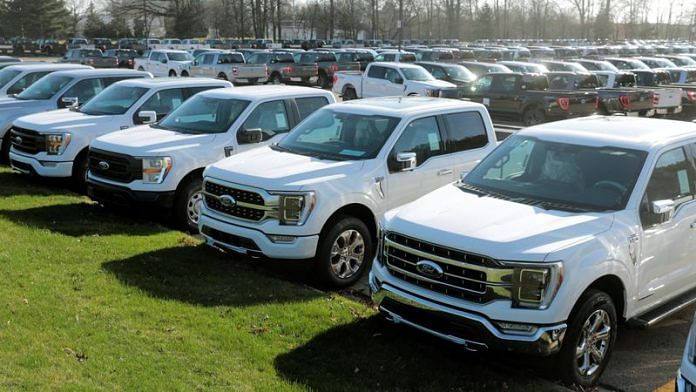By David Shepardson
WASHINGTON (Reuters) -President Joe Biden’s administration Friday finalized tighter vehicle fuel economy rules through 2031 that are significantly less stringent than first proposed, a win for the Detroit Three automakers who lobbied heavily for revised rules.
The National Highway Traffic Safety Administration said it would hike Corporate Average Fuel Economy (CAFE) requirements to about 50.4 miles per gallon by 2031 from 39.1 mpg currently. The new requirement is barely above the 49 mpg it previously required for 2026. Last year, NHTSA projected its tougher proposal would hike requirements to 58 mpg by 2032.
The agency said the proposed new rules will ultimately slash compliance penalties from what they would have been under the original proposal. It explained the change by noting automakers said “they cannot stop manufacturing large, fuel-inefficient light trucks while also transitioning to manufacturing electric vehicles.”
Environmental groups criticized the new rules as not strict enough, while automakers hailed the decision after calling the initial proposal unfeasible and warning it would result in dramatically higher vehicle prices.
Biden is running for reelection in November and working to build support among autoworkers and their unions, which had warned against the earlier vehicle proposals. Republican candidate Donald Trump has blasted the administration’s backing of EVs and stricter vehicle rules.
In July 2023, NHTSA had proposed boosting CAFE requirements by 2% per year for passenger cars and 4% per year for light trucks from 2027 through 2032. The final rule has no increase for light trucks for 2027 and 2028 and will only require 2% increases from 2029 through 2031.
Last year, NHTSA said its proposal to hike fuel economy standards through 2032 would cost the industry $14 billion in projected fines over a five-year-period. This includes $10.5 billion for the Detroit Three: $6.5 billion for General Motors,$3 billion for Chrysler parent Stellantis and $1 billion for Ford Motor.
Under the final rule, the auto industry is collectively expected to face a total of $1.83 billion in fines from 2027 through 2031 — and it could be as little as nothing — based on various models, NHTSA said.
NHTSA said GM could face $906 million in penalties through 2031, while Stellantis faces $368 million and Ford nothing.
Automakers, who buy credits or pay fines if they cannot meet CAFE requirements, separately face $1.5 billion in expected fines for the 2024-2026 model years. In June 2023, Reuters first reported Stellantis and GM paid a total of $363 million in CAFE fines for failing to meet U.S. fuel economy requirements for prior model years.
The is the third regulatory action the Biden administration has taken in recent months that tightened vehicle regulatory proposals less than promised. New compliance calculations for EVs that were less strict than proposed, and new tailpipe rules would ultimately require automakers to make fewer EVs than they had originally forecast.
John Bozzella, who heads the Alliance for Automotive Innovation trade group representing major automakers, praised the revisions.
“Those fines wouldn’t have produced any environmental benefits or additional fuel economy and would’ve foolishly diverted automaker capital away from the massive investments required by the electric vehicle transition,” Bozzella said.
Dan Becker, director of the Center for Biological Diversity’s Safe Climate Transport Campaign, said NHTSA had “caved to automaker pressure” and said the agency’s “weak final rule wastes too much gas, spews too much pollution and cedes the clean vehicle market to foreign automakers.”
Separately, NHTSA said it was finalizing new rules to boost heavy-duty pickup truck and van fuel efficiency by 10% annually from 2030-2032 and 8% per year from 2033-2035.
(Reporting by David Shepardson; Editing by David Gregorio)
Disclaimer: This report is auto generated from the Reuters news service. ThePrint holds no responsibilty for its content.



